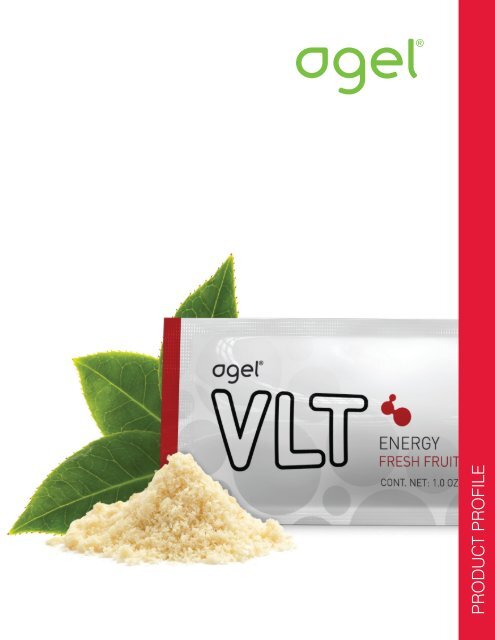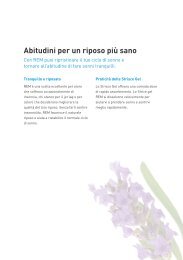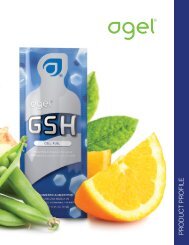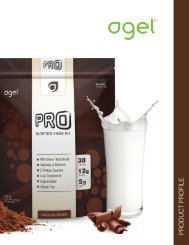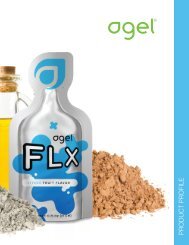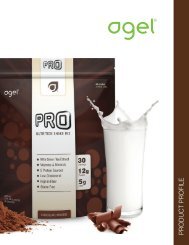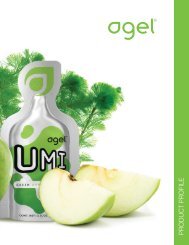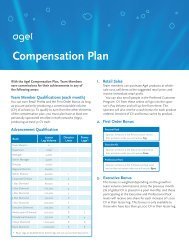View the VLT profile - Agel
View the VLT profile - Agel
View the VLT profile - Agel
Create successful ePaper yourself
Turn your PDF publications into a flip-book with our unique Google optimized e-Paper software.
PRODUCT PROFILE
Contents<br />
1<br />
2<br />
3<br />
4<br />
5<br />
6<br />
7<br />
8<br />
9<br />
10<br />
Introduction<br />
Marketing Summary<br />
Research Monograph<br />
Scientific Summary & Current Use<br />
Product Label<br />
Approved Claims<br />
Safety Cautions & Assessment<br />
Age Guidelines for Use/Shelf Life<br />
Glossary<br />
References & Additional Resources
PRODUCT PROFILES<br />
who we are...<br />
<strong>Agel</strong> Vision<br />
The Global Leader in Suspension Gel Technology<br />
based Nutritional Products<br />
<strong>Agel</strong> Purpose<br />
AGEL and our Product Profiles in Innovation,<br />
Research, Quality and Safety provide <strong>the</strong> necessary<br />
components for a confident, well-informed<br />
community of empowered team members<br />
through:<br />
• Safe and beneficial products<br />
• Clear and organized information<br />
• Compliance to well-defined systems<br />
<strong>VLT</strong><br />
1
Marketing Summary<br />
The energy you need.<br />
High-Energy<br />
This new high-energy <strong>Agel</strong> product combines caffeine, vitamins, and selected herbs to<br />
create <strong>the</strong> ultimate high-energy gel for active people. <strong>Agel</strong> <strong>VLT</strong> is an energy gel superior in<br />
effect to energy drinks. It provides <strong>the</strong> quick energy you need without <strong>the</strong> sudden crash*.<br />
<strong>VLT</strong> Benefits<br />
• Provides a sustained burst of energy in a suspension gel dosage form<br />
• Supports <strong>the</strong> syn<strong>the</strong>sis of ATP (natural fuel for <strong>the</strong> muscles)*<br />
• Vegetarian and non-gluten ingredients<br />
• Low glycemic ingredients<br />
• Excellent source of selected B vitamin ingredients and high potency anti-oxidant<br />
Vitamin C<br />
• Contains Acetyl L-Carnitine (ALC) that has been shown to reduce both physical and<br />
mental fatigue associated with aging. ALC is a precursor to <strong>the</strong> important brain neurotransmitter<br />
acetylcholine, which contributes to <strong>the</strong> support of cognitive function and<br />
memory**<br />
<strong>VLT</strong><br />
2<br />
**These statements have not been evaluated by <strong>the</strong> Food and Drug Administration. This product is not intended to<br />
diagnose, treat, cure or prevent any disease.
Research<br />
MONOGRAPH<br />
Product History<br />
& Traditional Use<br />
<strong>VLT</strong> is a new product introduction to <strong>Agel</strong> in 2011.<br />
It’s formulation represents emerging energy research<br />
coupled with traditional research on nutritional<br />
ingredients and caffeine. Naturally occurring caffeine<br />
is an ingredient in <strong>VLT</strong>.<br />
Caffeine containing plants have played an important<br />
role in <strong>the</strong> civilization of mankind. The cultural and<br />
historical use on caffeine containing plants dates<br />
back thousands of years. According to Chinese<br />
legend, Tea (Camellia sinensis) was discovered<br />
when leaves of tea fell into boiling water to create a<br />
refreshing and pleasant beverage. The Tea beverage<br />
is said to be <strong>the</strong> second only to water as a consumed<br />
beverage. Coffee played a role in cultures and<br />
traditions of Africa, Middle East before gaining<br />
acceptance in Europe. Chocolate use dates back<br />
to ancient civilizations in South America and it was<br />
esteemed as a form of valued currency. Guarana<br />
has been used by native South American peoples<br />
(including <strong>the</strong> Guaranis) for centuries and was<br />
introduced to European settlers as far back as <strong>the</strong><br />
16th century. Caffeine containing beverages have<br />
played a role in social settings as an element of <strong>the</strong><br />
cultural fabric of society and human interactions.<br />
Examples of caffeine containing plants are listed<br />
below:<br />
name scientific name source current use*<br />
Guarana Paullinia cupana South America Energy, Social<br />
Tea Camellia sinensis Asia Social Settings,<br />
Mild Energy<br />
Coffee Coffea arabica Africa, Middle East Energizing Stimulant<br />
Chocolate Theobroma cacao South America Currency, Energy<br />
Beverage, Anti-Fatigue<br />
Kola Nuts Cola nitida Western Africa Restorative Vitality<br />
Yerba Mate Ilex paraguariensis South America Social Beverage<br />
Yaupon Ilex vomitoria North America Social Beverage<br />
and Purification<br />
Description <strong>Agel</strong> <strong>VLT</strong> is a blend of naturally occurring caffeine, amino acids, and nutrients<br />
formulated in a suspension gel dosage form to deliver <strong>the</strong> energy nutrients you need.**Naturally occurring<br />
caffeine is an ingredient in <strong>VLT</strong>. Each <strong>VLT</strong> packet contains about 165mg of caffeine or about as much of 2-3<br />
cups of generic brewed coffee.<br />
<strong>VLT</strong><br />
3
Product History Continued<br />
The isolation and chemical characterization of<br />
caffeine dates back to early 19th century by German,<br />
French, and Swedish chemists. The chemical<br />
structure of caffeine was identified near <strong>the</strong> end of<br />
<strong>the</strong> 19th century by Hermann Emil Fischer. He was<br />
awarded <strong>the</strong> Nobel Prize in 1902 in part for his work<br />
on <strong>the</strong> syn<strong>the</strong>sis and characterization of caffeine.<br />
The naturally occurring chemical caffeine is one of<br />
<strong>the</strong> few substances that have been used as a food<br />
(natural flavoring as a bitter substance), dietary<br />
supplement, and as a drug (over <strong>the</strong> counter mild<br />
stimulant). The amount of caffeine and its labeling<br />
determine its use. In o<strong>the</strong>r words, <strong>the</strong> product<br />
dosage and amount of caffeine are two factors that<br />
determine whe<strong>the</strong>r caffeine has food, supplement,<br />
or drug applications. It is important to use caffeine<br />
responsibly. Label directions for caffeine containing<br />
products should be followed as misuse of this<br />
ingredient can lead to potential adverse reactions.<br />
vlt ingredient phytonutrient traditional use* current use**<br />
Caffeine Caffeine Food Flavor, Bitter,<br />
Energy<br />
Dietary Supplement, Food,<br />
Pharmaceutical<br />
Guarana Extract<br />
Caffeine,<br />
Theobromine,<br />
Theophylline<br />
Mood, Memory,<br />
Alertness<br />
Flavor, Energy,<br />
Pharmaceutical<br />
Glycine Glycine Nutrition Protein, ATP,<br />
Glutathione Syn<strong>the</strong>sis,<br />
Antioxidant<br />
Acetyl L-Carnitine Acetyl L-Carnitine Nutrition ATP Production<br />
Glucuronolactone Glucuronolactone Nutrition, Detoxification Dietary Supplement<br />
Vitamin C Vitamin C Scurvy Anti-oxidant Metabolic<br />
Support<br />
B Vitamins<br />
Vitamin B3 (Niacin),<br />
B6 (Pyridoxine), B12<br />
(Cyanocobalamin)<br />
Nutrients<br />
Endurance<br />
Check PRO<br />
<strong>VLT</strong><br />
4<br />
*Traditional use claims have not been verified by modern scientific research.<br />
**These statements have not been evaluated by <strong>the</strong> Food and Drug Administration. This product is not intended to<br />
diagnose, treat, cure or prevent any disease.
Scientific Summary<br />
& CURRENT USE<br />
Caffeine is used as a dietary supplement<br />
ingredient in <strong>VLT</strong>. There are about 165 mg of<br />
caffeine per <strong>VLT</strong> dosage that provide energy and<br />
nutritional support. Excessive dosages of <strong>VLT</strong><br />
combined with caffeinated beverages or o<strong>the</strong>r<br />
sources of caffeine should be avoided. The <strong>VLT</strong><br />
formulation is designed to incorporate a balanced<br />
amount of caffeine and o<strong>the</strong>r nutrients to provide<br />
short and longer term sustained energy. Energetic<br />
effects may last 3-4 hours and complement <strong>the</strong><br />
longer term energy impacts of <strong>VLT</strong> nutrients.<br />
Preliminary studies have demonstrated that subjects<br />
can cycle up to 29% longer during high-intensity<br />
circuits after taking caffeine in <strong>VLT</strong>.<br />
Guarana Extract A source of xanthine<br />
alkaloids including caffeine, <strong>the</strong>obromine and<br />
<strong>the</strong>ophylline. Guarana contains polyphenols,<br />
and catechins and epicatechins (Green Tea type<br />
nutrients). It is used as a popular carbonated soft<br />
drink and as a dietary supplement ingredient. It<br />
is used in <strong>VLT</strong> to complement <strong>the</strong> o<strong>the</strong>r nutritional<br />
ingredients with a balanced nutritional and flavor<br />
<strong>profile</strong>.<br />
Glycine acts to support <strong>the</strong> energy metabolism<br />
in <strong>the</strong> body. It inhibits and neutralizes free radicals<br />
that may form during extended exercise. It is key<br />
to <strong>the</strong> syn<strong>the</strong>sis of ATP, glucose and glycogen that<br />
provide energy to our bodies.<br />
Acetyl L-Carnitine is <strong>the</strong> acetylated form<br />
of L-carnitine. It increases ATP production on a<br />
cellular level in our mitochondria and plays a role<br />
in <strong>the</strong> body’s energy metabolism. It provides an<br />
impact to <strong>the</strong> cardiac and neuroprotective systems.<br />
Glucuronolactone is a precursor for<br />
Vitamin C syn<strong>the</strong>sis and both of <strong>the</strong>se substances<br />
have been demonstrated to play a role in structural<br />
and connective tissues in <strong>the</strong> body.<br />
B Vitamins & Vitamin C Each<br />
<strong>VLT</strong> dosage provides Niacin (B3 at 70% Daily<br />
Value), pyridoxine (B6 at 70% Daily Value) and<br />
cyanocobalamin (B12 at 23% Daily Value). Each are<br />
essential nutrients that have been associated with<br />
energy and wellness. Vitamin C at 40 mg or 67%<br />
DV per dosage is a recognized anti-oxidant and<br />
supports neutralization of free radicals. Vitamin C is<br />
recognized in supporting <strong>the</strong> structural elements of<br />
skin, tissues, and bone. Deficiency of Vitamin C has<br />
been identified as an element in scurvy (disease of<br />
<strong>the</strong> skin and mucous membranes). Each packet<br />
and dosage provides a rich source of B vitamins<br />
and Vitamin C.<br />
<strong>VLT</strong><br />
5
Product Label<br />
Take one <strong>Agel</strong> <strong>VLT</strong> packet a day<br />
<strong>Agel</strong> <strong>VLT</strong> has been specifically<br />
formulated to provide a sustained<br />
energy boost that supports<br />
concentration, focus and endurance.<br />
Allowing you to perform at your<br />
best. With B vitamins that are<br />
essential for energy, endurance and<br />
stamina and low in sugar, <strong>VLT</strong> gives<br />
you <strong>the</strong> energy you need now.*<br />
<strong>VLT</strong><br />
6
Approved Claims<br />
Key Ingredients<br />
Caffeine, Glycine, N-Acetyl-L-Carnitine, Glucoronolactone, B-Vitamins, B3 (niacin), B6 (pyridoxine),<br />
B12 (cyanocobalamin), Ascorbic acid (Vitamin C)<br />
approved<br />
Rich, excellent, or high source of high potency<br />
anti-oxidant (vitamin C).<br />
not approved<br />
<strong>VLT</strong> provides instant energy, all day long.<br />
Increases energy to support concentration,<br />
focus, and endurance<br />
Prevents sickness and disease.<br />
The sustained energy boost helps you perform<br />
your best. <strong>VLT</strong> is low in sugar which helps avoid<br />
<strong>the</strong> crash associated with many energy supplements<br />
AGEL <strong>VLT</strong> is a good source of vitamins and minerals.<br />
Take one packet of <strong>VLT</strong> to boost energy and<br />
alertness<br />
A safe and effective stimulant<br />
Notes<br />
1<br />
Not to be used at bed time or prior to retiring<br />
for sleep.<br />
2<br />
This product contains about 165mg of<br />
caffeine (about as much as 2-3 cups of<br />
generic brewed coffee. Do not take this<br />
product if you are pregnant, nursing, or<br />
sensitive to caffeine. Not for children.<br />
Consult your doctor before taking any<br />
dietary supplement.<br />
3<br />
<strong>VLT</strong> is a Vitamin B infused formulation of<br />
amino acids and natural caffeine to provide a<br />
daily boost of energy.<br />
4<br />
The <strong>VLT</strong> packet is 1.0 oz.(29.5 g). The<br />
existing typical <strong>Agel</strong> packet gels have a<br />
content of 0.75oz (21 g). The Omega 3<br />
packet content is 0.35 oz.(10 g).<br />
<strong>VLT</strong><br />
7
Safety Cautions<br />
& ASSESSMENT<br />
The safety issues with <strong>VLT</strong> are primarily associated with <strong>the</strong> caffeine content.<br />
<strong>VLT</strong><br />
8<br />
• Warning This product contains<br />
about 165 mg of caffeine (about as<br />
much as 2-3 cups of generic brewed<br />
coffee). Do not take this product if you<br />
are sensitive to caffeine.<br />
• Pregnant or lactating women (or those<br />
planning pregnancy) should consult<br />
<strong>the</strong>ir physician prior to using this<br />
product.<br />
• If you are planning a surgery, disclose<br />
use of <strong>Agel</strong> <strong>VLT</strong> and all o<strong>the</strong>r dietary<br />
supplements to your physician.<br />
• A dosage of one <strong>Agel</strong> <strong>VLT</strong> packet<br />
a day can be safely used by most<br />
people, unless <strong>the</strong>re is a reason not to<br />
use this product.<br />
• <strong>VLT</strong> is intended for adult use. Not for<br />
children. It is not intended for use in<br />
individuals under 18 years of age.<br />
• Dosages of more than 250-300 mg<br />
of caffeine (two <strong>VLT</strong> packets a day)<br />
have been associated with sleep<br />
disturbance and heart rate impact.<br />
• Caffeine has GRAS (Generally<br />
Regarded as Safe) status in <strong>the</strong> US.<br />
• Do not take <strong>VLT</strong> if you are planning to<br />
rest or retire to sleep.<br />
• Caffeine is an FDA approved<br />
ingredient in many over-<strong>the</strong>-counter<br />
drug products.<br />
• No observable adverse effect level of<br />
glucuronolactone at 1000mg/body<br />
kg/day. <strong>VLT</strong> has less than 100mg<br />
glucuronolactone per dosage.<br />
• LD50 of glycine is 7930 mg/kg in rats<br />
(oral). <strong>VLT</strong> has 250 mg of glycine per<br />
dosage.<br />
Key Ingredients<br />
Caffeine, Vitamin C, Vitamin B3, Vitamin B6, Vitamin<br />
B12, Glycine, Guarana ext, Acetyl L-Carnitine,<br />
Glucuronolactone
Age Guidelines<br />
FOR USE<br />
age group class approximate age use recommendation<br />
Newborn Birth to one month of age Not recommended for use<br />
Infant One month to 2 years Not recommended for use<br />
Child 2 years to 12 years Not recommended for use<br />
Adolescent 12 years to 17 years Not recommended for use<br />
Adult 17 years and older 1 packet daily<br />
<strong>Agel</strong> Guidelines<br />
1<br />
2<br />
Individual conditions should be considered when considering use, including weight,<br />
sex, pre-existing medical conditions, sensitivity or allergic reactions to ingredients,<br />
use of prescription medication or o<strong>the</strong>r drugs.<br />
Individuals should begin <strong>Agel</strong> product use with one <strong>Agel</strong> product at <strong>the</strong> lowest<br />
dosage and increase dosage and add o<strong>the</strong>r complementary <strong>Agel</strong> products as<br />
needed.<br />
Product Shelf Life<br />
<strong>Agel</strong> <strong>VLT</strong> has a shelf life of 18 months when stored under<br />
ambient conditions<br />
<strong>VLT</strong><br />
9
Glossary<br />
Acetyl L-Carnitine (ALC) The<br />
acetyl form of L-Carnitine useful for fatty acid<br />
metabolism.<br />
Adenosine Tri Phosphate (ATP)<br />
It transfers chemical energy within cells for<br />
metabolic reactions. It has been called <strong>the</strong><br />
“currency of cellular energy”.<br />
L-Carnitine Chemical compound that is<br />
required for utilization (transport and breakdown)<br />
of fats. Nitrogen containing product obtained<br />
from biosyn<strong>the</strong>sis of lysine and methionine.<br />
Glucuronolactone Chemical<br />
compound that is a structural component of<br />
connective tissue.<br />
Caffeine Naturally occurring phytochemical<br />
in selected plants. A xanthine alkaloid.<br />
Glucose Naturally occurring sugar.<br />
Glutathinone Tri-peptide chemical<br />
compound that acts as an antioxidant to protect<br />
cells from free radical oxidation or damage.<br />
Glycogen A polysaccharide that is <strong>the</strong> chief<br />
storage carbohydrate in animals.<br />
Glycine An amino acid. Key for <strong>the</strong> syn<strong>the</strong>sis<br />
of proteins, ATP, glutathione, glucose, glycogen<br />
and more.<br />
Xanthine Alkaloids Nitrogen containing<br />
chemical compounds based on <strong>the</strong> purine<br />
structure, including caffeine, <strong>the</strong>obromine, and<br />
<strong>the</strong>ophylline. Considered to be phytonutrients<br />
that act as mild stimulants and bronchodilators.<br />
<strong>VLT</strong><br />
10
References<br />
• Astorino TA, Roberson DW (January 2010).<br />
“Efficacy of acute caffeine ingestion for shortterm<br />
high-intensity exercise performance: a<br />
systematic review”. J Strength Cond Res 24<br />
(1): 257–65.<br />
• Baker EM, Bierman EL, Plough IC.<br />
1960. Effect of D-glucuronic acid and<br />
D-glucuronolactone on ascorbic acid<br />
levels in blood and urine of man and dog”.<br />
American Journal of Clinical Nutrition. 8:369-73.<br />
• Cao Y, Wang YX, Liu CJ, Wang LX, Han<br />
ZW, Wang CB (2009). “Comparison of<br />
pharmacokinetics of L-carnitine, acetyl-Lcarnitine<br />
and propionyl-L-carnitine after single<br />
oral administration of L-carnitine in healthy<br />
volunteers”. Clinical and Investigative Medicine<br />
32 (1): E13–9.<br />
• “Safety (MSDS) data for glycine” ( “http://<br />
physchem.ox.ac.uk/MSDS/GL/glycine.html”<br />
http://physchem.ox.ac.uk/MSDS/GL/glycine.<br />
html.) Weinberg BA, Bealer BK (2001).<br />
• Jellin JM, Gregory PJ, et al. Pharmacist’s<br />
Letter/Prescriber’s Letter Natural Medicines<br />
Comprehensive Database. 11th Edition.<br />
Stockton, CA: Therapeutic Research Facility.<br />
2009<br />
• Peters, Josef M. (1967). “Factors Affecting<br />
Caffeine Toxicity: A Review of <strong>the</strong> Literature”.<br />
The Journal of Clinical Pharmacology and<br />
<strong>the</strong> Journal of New Drugs (7): 131–141.<br />
<strong>VLT</strong><br />
11
• Nehlig, A; Daval, JL; Debry, G (1992).<br />
“Caffeine and <strong>the</strong> central nervous system:<br />
mechanisms of action, biochemical,<br />
metabolic and psychostimulant effects”. Brain<br />
Research Reviews 17 (2): 139–70.<br />
• Nehlig A (2010). “Is caffeine a cognitive<br />
enhancer?”. J. Alzheimers Dis. 20 Suppl 1:<br />
S85–94.<br />
• Weinberg BA, Bealer BK (2001). The World of<br />
Caffeine. Routledge.<br />
• If you would like to review <strong>the</strong>se publications<br />
in more detail we suggest you use PubMed,<br />
<strong>the</strong> information portal provided by <strong>the</strong> US<br />
National Library of Medicine and <strong>the</strong> National<br />
Institutes of Health. PubMed is a service<br />
of <strong>the</strong> U.S. National Library of Medicine<br />
that includes over 17 million citations from<br />
MEDLINE and o<strong>the</strong>r life science journals for<br />
biomedical articles back to <strong>the</strong> 1950s.<br />
Additional Resources<br />
<strong>Agel</strong> Product Profiles and Organization<br />
<strong>Agel</strong> Suspension Gel Technology FAQ<br />
US Regulatory Requirements<br />
European (EU) Regulatory Requirements<br />
<strong>Agel</strong> Primary Use for All <strong>Agel</strong> Products<br />
Responsible Use of <strong>Agel</strong> Nutritional Supplements<br />
<strong>Agel</strong> Compliant Claim Guidelines for All Products<br />
<strong>Agel</strong> Product Shelf Life (All Products)<br />
<strong>Agel</strong> Quality (QA/QC 2011)<br />
Product Profiles Listing of Item Numbers and Release<br />
Dates<br />
Product Certification (Halal and Kosher Lists)<br />
<strong>Agel</strong> Glossary (All Products)<br />
<strong>Agel</strong> Product Shelf Life<br />
<strong>Agel</strong> Quality (QA/QA 2011)<br />
• To find a reference on PubMed, copy <strong>the</strong><br />
reference for <strong>the</strong> article you want to read<br />
from <strong>the</strong> <strong>Agel</strong> Bibliography page and paste it<br />
in <strong>the</strong> “Search PubMed for” entry box on <strong>the</strong><br />
following web page:<br />
http://www.pubmed.gov<br />
<strong>VLT</strong><br />
12


